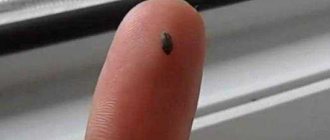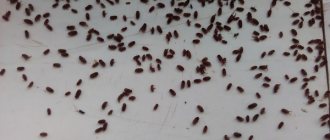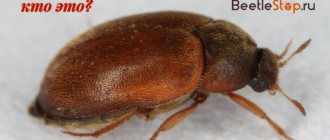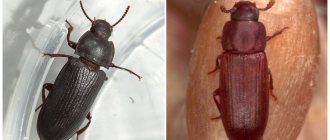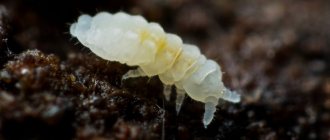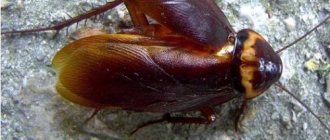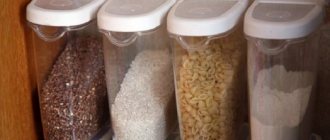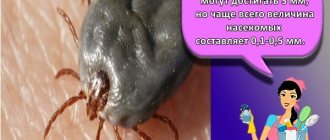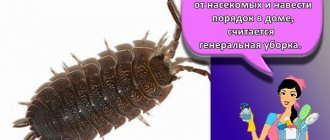It must be admitted that many have not heard anything about small black-brown beetles - leather beetles. Which is strange, because the skin beetle is not such a rare guest in the apartment.
“Carpet beetles are black or brown beetles, 1.3-12 millimeters long. The body can be either elongated or round. The integument is covered with scales or hairs...”
Wait, are you sure you are interested in reading this further? Let's leave the encyclopedic description for amateur entomologists. After all, in the end, skin beetles are unlikely to be interesting to most people in themselves. You usually have to look for information about them when pests make themselves known in the apartment, for example in the sofa or on the windows. But you also need to know about the weaknesses of the “enemy” in order to be a “winner”.
Who are leather beetles and what do they look like?
Are there little brown bugs in your house? In this case, a photo is necessary to find out what they look like and compare whether you really have skin beetles.
It seems that the name of these beetles speaks for itself. However, not all skin beetles respond to this and eat only the skin; their diet is too varied. To be more precise, the concept of “inedible” is not familiar to the skin beetle. Brown bugs feed on everything; they can equally successfully use both ordinary synthetic fabric and cardboard with glue as a substrate. Plastic or even plaster are also used (biting into the walls). And yet, the domestic leather beetle lives primarily on materials of animal origin. The exception is the fur coat beetle, which, contrary to its name, shows more interest in Hercules bread and oatmeal than in “fur coats”. Perhaps that is why the economic damage from it is not so great compared to its other relatives in the family.
Prevention methods
To prevent the skin beetle from entering the room, a number of measures are carried out:
- Ventilate regularly and do wet cleaning. Insects seek dry environments.
- Twice a year they go through clothes in closets. Lavender, wormwood, tansy, tobacco, and camphor are left on the shelves.
- In the kitchen, surfaces are often treated with vinegar, the garbage is taken out and the bucket is treated.
- Wash the floors thoroughly with the addition of cleaning products to wash away the larvae from the cracks.
- Mosquito nets are hung on the windows.
- Create conditions for storing cereals and other food products.
Washing powders, bleaches, ammonia, and chlorine have no effect on kitchen pests. If you were unable to get them out of the house yourself, specialists will come to the rescue. To clear your apartment of uninvited guests, you may have to leave your home for several days.
For what materials is leather beetle dangerous?
Carpet beetles primarily pose a danger to products made of leather, fur, silk, wool, skins, felt, hair, horns, feathers, down, etc. The beetles will also not refuse the following foodstuffs: meat, cheese, dried and smoked fish, powdered milk , some types of grain products.
An alternative to natural food in the form of glue, including that contained in book bindings, seems very “tasty” to the skin beetle. Cardboard, asbestos, rubber or plastic from which the cables are made - all this can also be damaged if skin beetles appear in the apartment.
Reproduction process
Carpet beetles reproduce quite actively. During the period of life, for the first and subsequent times, the female is capable of hatching from ten to several hundred eggs. The female prefers to lay eggs in fleecy things, on woolen surfaces, in bedding, in stuffed animals, and upholstered furniture. After the eggs have been laid, the female dies. The incubation period for the development and maturation of eggs ranges from 2 to 55 days on average. The development of eggs depends on the temperature in the room. After they mature, the eggs hatch into larvae. They can mature into adults in up to 2 years.
It is important to know! An unfavorable environment for larvae is low temperature, dampness, and bright light. Favorable conditions include optimal room temperature, dim light, and low air humidity.
Where do skin beetles live in an apartment? How to find these beetles?
Adult beetles fly around the apartment and can unexpectedly and loudly “fly into someone’s forehead” without calculating their flight path. Until this happens, it is better to be the first to find those who replenish their fat reserves by destroying valuable materials. The beetle prefers warm, dry places; they can often be found near a radiator, on a windowsill, in a closet drawer, as well as under carpets, in and near sofas, in mattresses, etc. Skin beetles are often seen in the kitchen; for example, many people find beetles with their legs upside down on the kitchen stove.
There can be much more beetles than it might seem at first glance, because most of them are hidden from human eyes in the form of larvae that have gnawed into the substrate, which are actually engaged in sabotage of valuable materials, products, etc. Until you find out what attracts beetles to your home, it will be impossible to localize the source of their spread.
Carefully inspect your sofa, especially its upholstery, from all sides. This place is the most frequent stronghold of skin beetle larvae.
It also happens that there is simply no specific outbreak - clothes in closets, contaminated cereals, etc. For example, carpet beetles choose hard-to-reach places from which dust and dirt are rarely swept away, or where they accumulate most quickly. The larvae of these beetles feed on a layer of dust, small pieces of various materials - paper, carpet lint, hair and various organic debris. This kind of residue appears in any apartment within a couple of days after cleaning, under cabinets, beds, etc. (even if no one lives in it).
“Where do skin beetle larvae most often like to settle? Under the baseboards. Trite? Maybe, but sometimes there’s just nowhere for them to hide like underneath.”
Adult Smirnov's skin beetles, as a rule, crawl onto windows and lamps; they can be found between window frames or inside lamp shades.
How to prevent insects from appearing on windows
Before we talk about fighting insects, let's consider the reasons why they appear and ways to prevent their occurrence.
So, in homes, midges most often appear on windows, or rather, Drosophila flies. These are absolutely harmless insects, however, they are annoying and unpleasant. Moreover, they reproduce very quickly.
Meet the Drosophila fly, or just a midge
As a rule, fruit flies appear on windows for the following reasons:
- leftover food. It is enough to leave a half-eaten apple, a slice of watermelon or a banana skin on the windowsill, and fruit flies will immediately appear on the window. Therefore, make sure that food is not left open indoors.
Leftover fruit is the favorite food of midges
Top 6 skin beetles by prevalence in Russia
The leather beetle family includes 600 species of beetles, many of them are morphologically similar to each other. However, out of all the variety of subfamilies and species, only seven are dangerous pests. They pose the most serious threat to food, things, and indeed the sanitary and epidemiological situation of the apartment as a whole. And it’s not so easy to find out what type of skin beetle the uninvited guest belongs to. To get rid of them, by and large, you don’t need to know this, because the tactics for exterminating all skin beetles are approximately the same.
There are 4-5 types that are comfortable in a city apartment. It should be noted that they can get along just fine without fur and with leather.
1. Ham skin beetle is the most common on the Eurasian continent. It can start in a person's house. The ham skin beetle is found quite often in apartments. The beetle is oblong in shape, black in color, with a yellowish-gray (or brown) part at the top of the wings.
2. Carpet beetles - this is the common name for a small group of 2-3 dark brown leather beetles, which are united by the fact that they are able to feed only on particles of house dust containing the smallest organic debris (fur coat beetles, carpet beetles, etc.). Often found in everyday life. Only the larvae feed; the adult beetle goes without food, using up its accumulated fat reserves.
Most likely, having discovered several such strange individuals, it will never occur to anyone that it is a skin beetle, especially if you do not know that it grows in houses. They are most often called by what they look like—little brown bugs.
3. Smirnov’s carpet beetle is a small brown bug reaching a maximum of 3 mm in length. It was brought to Russia about half a century ago, but during this time it managed to adapt to living in private houses and became a full-fledged synanthrope. It is this type of skin beetle that loves windows and window sills in apartments.
4. The fur coat beetle is a black spotted beetle with five small white spots on the back. It is not as harmful as other species, and is also quite rare in apartments. But if he gets into an apartment, he mostly eats food, but does not touch the products.
5. Museum and house leather beetles - they can live in flowers in apartments and houses, but are practically not found in home life, despite the fact that the name of the latter is “brownie”.
6. Frisch's carpet beetle is a black oval beetle; in our practice, there have been no cases of infestation of apartments with this species.
The most common species of carpet beetles in the European part of Russia and Siberia are the carpet beetle and the Smirnov carpet beetle. These are the so-called “little brown bugs on window sills and plastic windows.” But it is not uncommon for both ham and fur skin beetles to appear in the house (the latter of which is black spotted).
Carpet beetles are classified as pests of supplies and materials; in terms of their importance for household and industrial farming, as well as biology and behavior, they are quite similar to moths in many ways. This leads to similar tactics of extermination and struggle.
Are there any bugs? This means their larvae are somewhere. If you find these beetles hanging motionless on curtains, ceiling, etc. – these are also skin beetles. They may play dead by rolling over on their back, leading you to think they are not a threat. The constant presence of black or dark brown beetles (on plastic windows, frames, etc.) in an apartment tells us that some room is being damaged by larvae. This fact is an indisputable truth. This is similar to the conclusion that we are accustomed to making when we see moths flying, indicating that old clothes in a dusty mezzanine are certainly eaten by caterpillars.
Larvae . The presence of skin beetles can be determined by the hairy larvae with long, sometimes colored “tails.”
They are often confused with moth larvae in cabinets.
In an apartment, skin beetle larvae are often found in the sofa or some furniture. As a rule, larvae are discovered completely unexpectedly and by accident, and they are described as brown or striped worms. If there are worms in the sofa, this means that skin beetles have appeared in the apartment. The caterpillars in the sofa are the same skin beetle larvae. Pulling back the edge of the blanket, you can see these slightly light larvae on the mattress.
The face of the enemy
The carpet beetle is a coleopteran insect. They are black or brown in color, with a body up to 12 mm long and elongated or round in shape. The bug is covered with hairs or scales.
This little parasite multiplies rapidly. And the larvae can live without food for five years.
In nature, skin beetles play the role of a recycler of dust, wool, feathers, and bones of dead animals. These are natural cleaners. Since humans are actively destroying their natural habitat, they have to move into apartments.
Uninvited guests enter houses mainly in the summer through open windows and vents. Also, household members can bring them themselves along with some things - books, carpets, furs, upholstered furniture. The parasite can also hide a newly purchased flower pot.
Carpet beetles are not at all harmless. They are harmful to human health. One bite of a small bug, and the household members have picked up some kind of viral infection or become infected with helminths. A bite can also cause an allergic reaction - unbearable itching in the bitten area.
The parasite must be removed as soon as possible. It is necessary to destroy not only the bugs themselves, but their caterpillars and all larvae.
Checklist for assessing the degree of harmfulness of infection
For larvae of skin beetles of all types, a nutrient medium is vitally needed that would supply them with keratin-containing elements - horny particles, hair, fur and all animals, plant and artificial, the like. In your apartment, pay attention to what can serve as such a source for skin beetles:
- Do you keep stuffed animals or birds at home, or maybe a collection of insects? Consider that a source has been discovered. If there is fur at home, but the leather beetles have not yet reached these things, it is quite possible that the conditions for the beetles are unsuitable, and the eggs develop slowly. This usually happens when the house is cold or damp.
- Do you have a rare collection of tomes, or do you just like to keep books at home? Take care of the safety of their bindings.
- Have you recently bought something special made from materials that the leather beetle happily eats? Find the larvae and all adult beetles as soon as possible and destroy them before they multiply and completely damage new things. Perhaps these materials served as a source of infection.
- Do you have a cat? Is she also long-haired? It may not be easy to remove skin beetles. The fact is that in the apartment where the cat lives, a lot of hair always collects on the floor, it falls out regularly, and therefore it is necessary to remove it from surfaces often, at least every other day. Otherwise, the skin beetle larvae will always be provided with food.
Whatever the reason for the appearance of skin beetles in the apartment, it is important to start getting rid of them as soon as possible.
Vadim Verevkin
Please rate the material
comments powered by HyperComments
Treating the premises after getting rid of insects
If the fight against arthropods is successful, you need to take some steps to avoid encountering them again in the near future:
- we do the cleaning . Places where insects have accumulated must be washed using detergents;
Wash windows using detergents - this will get rid of traces of insects
- sorting out the products . Storage areas for vegetables and fruits also need to be washed. In this case, it is necessary to sort out the products. If rotten vegetables or fruits are found, they must be disposed of;
- We are taking preventive measures . We install the net and make sure that there are no food residues left in the room.
